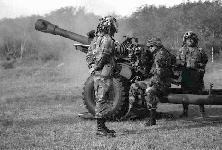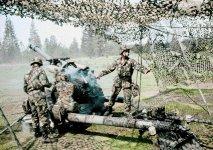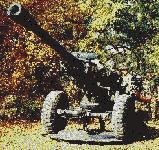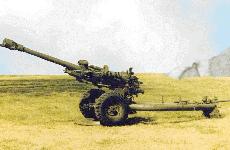The M119A1 has greater range, is lighter and has a more rapid rate of fire than its predecessor, the M102, which it replaces in light/ airmobile/airborne units. The M119 weights 4,000 pounds ( complete with BII). The prime mover is the HMMV truck. The M119 is air transportable with its basic load of ammunition by the UH60 helicopter and is dual lift capable with the CH47 Chinook. The M119 fires all current 105-mm ammunition and new propellant is being developed to give the M119 an increased range to approximately 19K with the rocket assisted projectile.
- Added U.S. standard fire control (digital)
- Increased low-temperature capability from -25 F to -50 F
- Improved interchangeability of spare/repair parts
- Simplified tail light assembly (standard M198 Howitzer lights)
- Improved trail access cover
- Reduced maintenance on the elevating clutch
- Increased trail life
- Improved maintainability on: Saddle and Cut-off gear
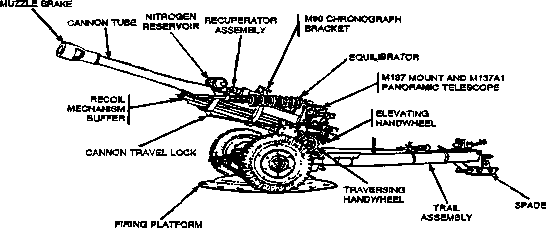
PERFORMANCE SPECIFICATION
Major Item............................................... Model M119A1
M119A1 National Stock Number...... 1015-01-308-1872
Weight:
Cannon......................................1,389 lb (630 kg)
With Complete BII.................... 4,520 lb (2050.3 kg)
Without BII............................... 4,100 lb (1869.7 kg)
Tire Size.................................... 9.00 x 16 (6 ply)
Tire Pressure............................. 37 psi (255.1 kPa)
Maximum Range........................11,500
m w/Chg 7
..................................................14,000 m w/Chg 8
..................................................19,000 m w/M913 RAP
Designated Prime Movers........... HMMWV (M1097)
Dimensions (travel conditions):
Length (folded position).......................................16 ft (4.87 m)
...........(with tube in firing position)...................... 20 ft 9 in. (6.32 m)
...........(with tube locked in tube clamp................ 20 ft 2 in (6.15m)
Width.................................................................. 5 ft 10 in (1.78
m)
Height (folded position)....................................... 4 ft 6 in (1.37 m)
.....(with cannon tube locked in tube clamp)......... 7 ft 3 in (2.21 m)
Lunette Load...................................................... 386 lb (175 kg)
Elevation Range..................................................-100 to +1244 mils
Maximum Terrain Side Slope.............................. 90 mils
Rate of Fire:
Max....................................................... 6 rounds per min for 2 min
Sustained............................................... 3 rounds per min for 30 min
Recoil Length at 0 Mils Elevation............ 42 in (1.07 m)
Recoil Length at 1244 Mils Elevation......14.5 in (0.36 m)
Maximum Towing Speed:
Folded................................................ Safe speed for vehicle towing
Ammunition
The M119A1 fires all standard NATO ammunition, including the M1 High Explosive, M314 Illuminating, M60/M60A2 White Phosphorous (smoke). In addition, the M119A1 can fire the newer extended range ammunition shown in the following table:
105mm AMMUNITION PROGRAM
M913 HERA & M760 HE CARTRIDGES
| REQUIREMENT | M913 HERA | M760 HE |
| WEAPON | M119A1 | M119A1 |
| MAX Range (Rkt ON) @800 Mils (Rkt OFF) MIN Range (Rkt ON) ...........(Rkt OFF) |
19.5kM 15.0kM 13.8kM 12.2kM |
Non-RAP 14.5kM Non-RAP 2.5kM |
| Precision | <0.35 PEr <1 Mil PEd* |
SAME SAME |
| Oper. Reliability PROJ. EFFECTIVENESS |
>98% 1.8 times M1 w/TNT |
SAME 1.0 times M1 |
*LOW ANGLE FIRE
Prime Mover
Even though the M119A1 can be pulled with any number of vehicles manufactured throughout the world, the U.S. Army uses the tough, reliable, and combat proven High Mobility Multi-purpose Wheeled Vehicle (HMMWV).



